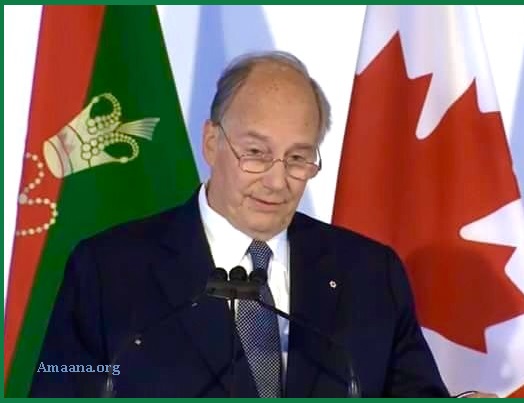 His Highness the Aga Khan Speech at the Inauguration of the Aga Khan Park, Toronto
His Highness the Aga Khan Speech at the Inauguration of the Aga Khan Park, Toronto
Video of Agreement Signing below
May 25th 2015
Bismillah-ir-Rahman-ir-Rahim
The Honourable Kathleen Wynne
Madame Clarkson
Mrs. Weston
Excellencies
Honourable Ministers
Mayor Tory
Distinguished Guests
Madame Premier may I thank you for your most warm and thoughtful words on this occasion. The Ismaili community are relatively recent arrivals in Canada and they’ve been here really as a result of the sorts of situations that you’ve mentioned including Karachi where people of different groups, different faiths, different ethnic backgrounds, have lived in societies governed by fear, pain, poverty, insecurity… an inability to predict anything into the future for themselves, or for future generations.
And what happened in Uganda with Idi Amin, you all know. I don’t need to remind you of that. And Canada and the province of Ontario opened their arms. And you said, please come to Canada. There’s a joke, which I may repeat to you, of a Canadian who goes into an Ismaili home. He sees a big picture of Idi Amin on the wall. What’s that? Why is he there? And the answer from the Ismaili family is that every day we thank him for throwing us into Canada.
Many of you will remember the day when we formally opened two stunning buildings on this site, the Aga Khan Museum and the Ismaili Centre. That was just eight months ago. We promised that we would be back in the spring to dedicate the park that joins those two buildings. Spring would be a time, we thought, when the park’s natural beauty could be seen to the fullest advantage. And I have to admit that I spent much of this morning wondering whether it was going to rain or not!
Well, spring is here, and here we are! And what a privilege it is to share this occasion with all of you.
I spoke last September of the spirit of friendship which infused this project from its very beginnings. And surely that is the spirit that fills our hearts today.
The building process here on Wynford Drive began five years ago – and that is not just a rough estimate. We actually launched the process on May the 28th, 2010 – five years ago almost to the day!
But the complex project that now culminates actually began much earlier – back in 1996 – when we first started planning for a new Ismaili Centre in Toronto. At that time the community was looking at Toronto, it was looking at Vancouver. I was in the uncomfortable position of having to keep an equitable balance between the East and the West. And as a result the Ismaili community is presided over every term by either a member of the Jamat from the East or from the West. And I have to warn you Madame Premier that the president of my community today is from – guess where? Not here!
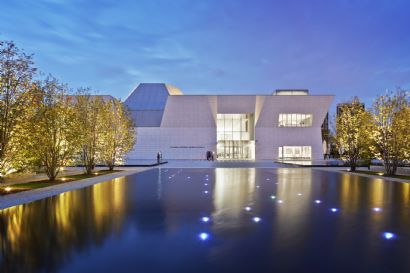 We began by locating this site. But then, our plans expanded as an adjacent site also became available. Happily, with the help of many friends, we were able to obtain the added land and the permission for our plans to be accepted.
We began by locating this site. But then, our plans expanded as an adjacent site also became available. Happily, with the help of many friends, we were able to obtain the added land and the permission for our plans to be accepted.
And here I would like just to thank Madame Bata. It was Madame Bata who made it possible for us to have the additional land we needed. We were able to develop two magnificent portions of the land with the park in between and that is thanks to you. Thank you.
I think of so many who helped us to advance this project, including young Ismailis who told our interviewers of their hopes that the Centre could be a place of lively social exchange – but not only among Ismailis. It was just as – if not more important – that they were able to talk to other Toronto neighbours.
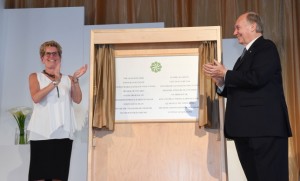 I think, too, of so many community members who helped us to advance our shared dreams. I think of the inspired artists who gave shape to those dreams – and those who then turned those visions into physical reality. And I think of so many others who provided vital assistance including officials at all levels of government. And again, I want to express my community’s and my gratitude to everyone in government who has made this lovely park come into existence.
I think, too, of so many community members who helped us to advance our shared dreams. I think of the inspired artists who gave shape to those dreams – and those who then turned those visions into physical reality. And I think of so many others who provided vital assistance including officials at all levels of government. And again, I want to express my community’s and my gratitude to everyone in government who has made this lovely park come into existence.
We learned a great deal from this experience. We learned that patience is rewarded. We learned that the unexpected can often become a blessing. We learned, once again, that civil society is cemented when people of many backgrounds come together in places of peace and joy, of inspiration and contemplation, of interaction and of common purpose.
I hope this park will contribute to strengthening Toronto’s already vibrant pluralism, showcasing to the world Canada’s rich example of pluralism in action.
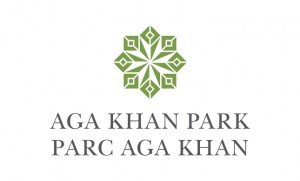 Cette conjonction d’efforts de si nombreux Canadiens en faveur de cette initiative, je la situe dans le contexte de ce partenariat vivant, sur tant de fronts, qui nous lie au gouvernement et au peuple canadien, qu’il s’agisse de réalisations locales un peu partout au Canada, qu’il s’agisse de projets d’envergure nationale conduits en commun, tel que le Centre Mondial du Pluralisme à Ottawa, ou encore de notre coopération en faveur du développement de l’éducation, de la santé et de la culture dans le monde, toutes choses qui nous permettent de poser des fondations nouvelles en faveur du progrès humain.
Cette conjonction d’efforts de si nombreux Canadiens en faveur de cette initiative, je la situe dans le contexte de ce partenariat vivant, sur tant de fronts, qui nous lie au gouvernement et au peuple canadien, qu’il s’agisse de réalisations locales un peu partout au Canada, qu’il s’agisse de projets d’envergure nationale conduits en commun, tel que le Centre Mondial du Pluralisme à Ottawa, ou encore de notre coopération en faveur du développement de l’éducation, de la santé et de la culture dans le monde, toutes choses qui nous permettent de poser des fondations nouvelles en faveur du progrès humain.
Permettez-moi d’exprimer de nouveau ma gratitude à la Première Ministre de l’Ontario, Madame Kathleen Wynne, pour sa présence aujourd’hui.
En début d’après-midi, la Première Ministre et moi-même avons signé l’Accord de Coopération qui, tout à la fois, institutionnalise les relations entre l’Ontario et l’Imamat Ismaïli et lance de nouvelles initiatives de collaboration.
Un exemple: nous voulons faire progresser la connaissance des civilisations de l’Islam par l’éducation, mission qui est en parfaite harmonie avec celle du Musée Aga Khan.
Autre exemple: nous souhaitons, au sein du nouveau Centre Ismaïli, susciter des occasions de dialogue sur la société civile en ayant notamment à l’esprit la qualité de vie des nombreuses communautés en Ontario.
Ainsi, cette journée est grande car elle marque l’aboutissement d’un magnifique projet, mais aussi parce qu’elle est l’occasion de nouveaux départs.
I have already mentioned one word that expresses the significance of this day, and that is the word: “Completion.”
But allow me to suggest one other word that also leaps to mind today. And that is the word: “Connection.”
In the first place, of course, we celebrate a striking new “connection” between the two buildings we dedicated last year. The Aga Khan Park now connects those buildings in a special way – not just as a passage way, or empty space between two structures, but as a work of art in its own right.
The Park grows out of the inspiration of its Lebanese architect, Vladimir Djurovic – and I think you will agree that it possesses its own strong artistic identity. That identity completes and connects these two buildings.
Too often in recent years, urban architecture – under pressure from urbanising rural populations, greater human longevity and shrinking budgets – has neglected the importance of open spaces in a healthy city landscape. We keep crowding more buildings into dense concentrations while short-changing the enormous impact that well designed open spaces – green spaces – can have on the quality of urban life.
To restore and create beautiful green spaces has become a prime goal of the Aga Khan Trust for Culture – with some ten notable achievements in places ranging from Cairo to Zanzibar, from Delhi to Kabul, from Dushanbe in Tajikistan to Bamako in Mali. And more projects are coming, including two contemporary Islamic Gardens to be built at the University of Alberta and in Burnaby.
The Aga Khan Park in Toronto will be an added prime example of the inspired, intelligent development of significant open spaces.
The Park and its Gardens can serve as a symbol of “connection” in other ways as well. Among them are rich connections across time linking us to the past.
The Garden has for many centuries served as a central element in Muslim culture. The Holy Qur’an, itself, portrays the Garden as a central symbol of a spiritual ideal – a place where human creativity and Divine majesty are fused, where the ingenuity of humanity and the beauty of nature are productively connected. Gardens are a place where the ephemeral meets the eternal, and where the eternal meets the hand of man.
The tradition of Islamic Gardens places an emphasis on human stewardship, our responsibility to nature and to protect the natural world. We see that principle expressed in the disciplined use of geometric form – framing the power and mystery of nature.
And, of course, the Garden of ancient tradition, like the Garden here today, is a place where – whatever difficult moments may come our way – we can always find, in the flow of refreshing water, a reminder of Divine blessing.
As we walk through this place we can feel a deep sense of connection with those who walked through similar gardens centuries ago. And, by renewing our connection with the past, we can also connect more effectively with one another – and, indeed, with those who will walk these paths in the future.
Finally, let me mention one other point of profound connection that we should ponder, and that is the connection across cultures. Think for example, of those who designed this complex. On one side, looking at the Museum, we see the work of a Japanese master. On the other side, looking at the Centre, we see the work of an Indian architectural giant. And in between we recognize the masterpiece of a young landscape artist of Lebanese descent.
All of this, of course, is done in the service of rich Islamic traditions – expressed in a 21st century idiom. And it is all set, in a Canadian context, where the ideals of cultural pluralism are so deeply rooted.
The age-old question is a profound one. How can human-kind honour what is distinctive about our separate identities and, at the same time, see diversity itself as a source of inspiration and blessing? Rather than fearing difference, how can we learn to embrace difference so that we can live together more peacefully and productively?
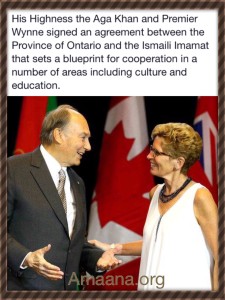 This city and this country have been among the world leaders in providing positive answers to that ancient question.
This city and this country have been among the world leaders in providing positive answers to that ancient question.
I understand that a local public school, the Thorncliffe Park School, just a few kilometres from this site, has students who trace their origins to almost 50 different countries. That is just one school, but it speaks to the rich diversity of local community life.
Sadly, there are too many moments when differing identities lead to worlds of fierce belligerence. At such moments, it becomes even more important that we reaffirm the human capacity to connect across lines of division.
One reason I take such joy from our experience here today is that this project sends a profoundly encouraging message about the human capacity to and for cooperative connection.
So thank you again for joining with us at this important moment – a time of satisfying completion, and of profound connection – across cultures, across generations and across the ages, not only with those who have gone before us but also with those who will come after.
Thank you.
Source: www.akdn.org
Related:
Province of Ontario and Ismaili Imamat Agreement of Cooperation Signing Ceremony (Toronto, Canada)
Madame Prime Minister, I want to tell you how happy and grateful my community and I are for this agreement that we have just signed.
Our history, our interpretation of our faith, is anchored in the intellect and we rejoice in investing in the human intellect. It’s part of the ethics of what we believe in and it’s part of what we believe distinguishes us, obviously, from the environment in which we live. So the agreement that we have is giving us new opportunities to widen our exposure to education in the industrialised world, but to widen that education within a context where our values are the same. And that it is very important, because it’s clear with a global community — such as the Ismaili community — we need to invest in global values, in values which can be applied to any society, at any time in any part of the world. And this what we are finding in Canada — that we will have a partnership with you — and in investing in that partnership we’re investing in a profession which, I have to say, has difficulty in the developing world.
There are three professions in the developing world which are undervalued. The first is nursing. The second is education. And the third is journalism. And yet all those professions are critical for the development of a quality civil society in the third world. And the partnership you have allowed us to create, is going to come in and assist us to reposition one of the greatest professions that we need in the third world. So I would as you to think of this not only in terms of what we will be able to achieve in terms of collaboration, but in the much wider context of the teaching profession and its position in the developing world.
But then we were discussing something else. We were discussing dialogue. We were discussing policy. We were discussing what ideas we need to move forwards in various parts of the developing world. And sharing these ideas — talking about them, openly and freely, but within the context of common values, shared values — is an absolutely wonderful opportunity. And I thank you very much for making that possible.
Thank you
His Highness the Aga Khan IV, Mowlana Hazar Imam Karim Al-Husayni
Source:
Video: http://original.livestream.com/premierofontario/video?clipId=pla_9de3ee12-b4fe-453c-a93d-cf93ef40e46f
Also view:
- New Aga Khan Park website
- WEBCAST: Aga Khan Park opening in Toronto
- Aga Khan Park is for now and forever
- Aga Khan Speech at Foundation Ceremony Museum at Humayun’s Tomb
- The Peterson Lecture by His Highness the Aga Khan to the IB 40th Annual Meeting
-
 Collection of Speeches by His Highness the Aga Khan at the Ismaili Web
Collection of Speeches by His Highness the Aga Khan at the Ismaili Web
 Collection of Interviews of His Highness the Aga Khan at the Ismaili Web
Collection of Interviews of His Highness the Aga Khan at the Ismaili Web
 Mowlana Hazar Imam’s Speeches on Islamic Architecture
Mowlana Hazar Imam’s Speeches on Islamic Architecture
Ya Ali Madad,
Ya ali madad
I am proud that I am an Ismaili member